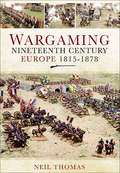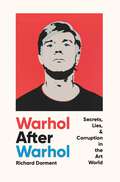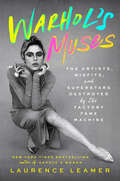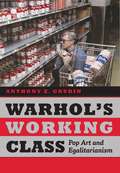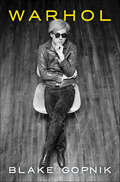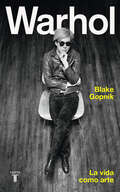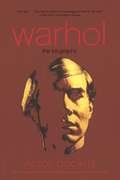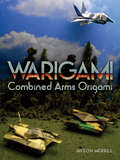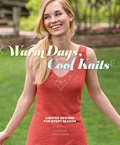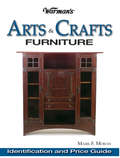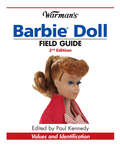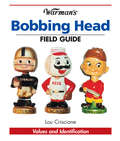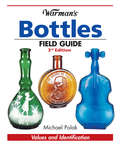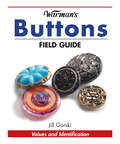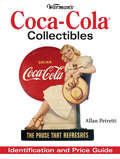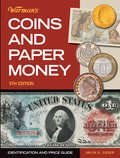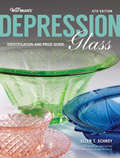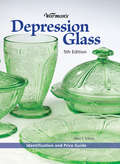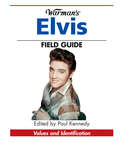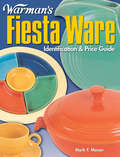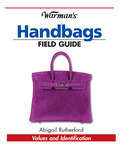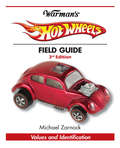- Table View
- List View
Wargaming: Nineteenth Century Europe, 1815–1878
by Neil ThomasA set of simple, fast-playing rules for wargaming the conflicts that re-shaped Europe in the period 1815-78. This important, yet often-neglected period includes the Crimean War, the Italian Risorgimento, the wars of Bismarck's Prussia against Denmark, Austro-Hungary and France and the Russo-Turkish war. Tactically it saw armies struggle to adapt Napoleonic doctrines to incorporate important technological advances such as breech-loading rifles, steel breech-loading cannon and the first machine guns. The book includes brief analysis of the essential strategic and tactical military developments of the period, a set of elegantly simple rules which are fast-playing and easy to learn, yet deliver realistic outcomes. A selection of generic scenarios, covering diverse situations such as flank attacks, pitched battles and meeting engagements, is supported by army lists for 28 different armies. There are also 12 historical scenarios, ranging from the Battle of the Alma in the Crimean War to Sedan in 1870, the decisive battle of the Franco-Prussian War, each with historical background, deployment map, orders of battle and any special rules for that engagement. Useful appendices include a guide to further reading, an overview and price guide to the many scales and ranges of figures available, and a selection of useful addresses for the gamer.
Warhol After Warhol: Secrets, Lies, & Corruption in the Art World
by Richard DormentLong-time art critic Richard Dorment reveals the corruption and lies of the art world and its mystifying authentication process.Late one afternoon in the winter of 2003, art critic Richard Dorment answered a telephone call from a stranger. The caller was Joe Simon, an American film producer and art collector. He was ringing at the suggestion of David Hockney, his neighbour in Malibu. A committee of experts called the Andy Warhol Art Authentication Board had declared the two Warhols in his collection to be fake. He wanted to know why and thought Dorment could help.This call would mark the beginning of an extraordinary story that would play out over the next ten years and would involve a cast of characters straight out of a n novel. From rock icons and film stars; art dealers and art forgers; to a murdered Russian oligarch and a lawyer for the mob; from courtrooms to auction houses: all took part in a bitter struggle debating the authenticity of a series of paintings by the most famous American artist of the twentieth century.Part detective story, part art history, part memoir, and part courtroom drama, Warhol After Warhol is a spellbinding account of the dark connection between money, power, and art.
Warhol's Muses: The Artists, Misfits, and Superstars Destroyed by the Factory Fame Machine
by Laurence LeamerONE OF &“12 NEW NONFICTION BOOKS YOU NEED TO READ IN 2025&”—THE OBSERVERA &“MUST-READ&” BOOK OF SPRING 2025 – TOWN & COUNTRYONE OF &“25 BOOKS TO READ IN 2025&”—TORONTO STARFrom the New York Times bestselling author of Capote&’s Women comes an astonishing account of the revolutionary artist Andy Warhol and his scandalous relationships with the ten women he deemed his &“Superstars&”.&“Now and then, someone would accuse me of being evil,&” Andy Warhol confessed, &“of letting people destroy themselves while I watched, just so I could film them.&” Obsessed with celebrity, the silver-wigged artistic icon created an ever-evolving entourage of stunning women he dubbed his &“Superstars&”—Baby Jane Holzer, Edie Sedgwick, Nico, Ultra Violet, Viva, Brigid Berlin, Ingrid Superstar, International Velvet, Mary Woronov, and Candy Darling. He gave several of them new names and manipulated their beauty and talent for his art and social status with no regard for their safety, their dignity, or their lives.In Warhol&’s Muses, bestselling biographer Laurence Leamer shines a spotlight on the complex women who inspired and starred in Warhol&’s legendary underground films—The Chelsea Girls, The Nude Restaurant, and Blue Movie, among others. Drawn by the siren call of Manhattan life in the sixties, they each left their protected enclaves and ventured to a new world, Warhol&’s famed Factory, having no sense that they would never be able to return to their old homes and familiar ways again. Sex was casual, drugs were ubiquitous, parties were wild, and to Warhol, everyone was transient, temporary, and replaceable. It was a dangerous game he played with the women around him, and on a warm June day in 1968, someone entered the Factory and shot him, changing his life forever.Warhol&’s Muses explores the lives of ten endlessly intriguing women, transports us to a turbulent and transformative era, and uncovers the life and work of one of the most legendary artists of all time.
Warhol's Working Class: Pop Art and Egalitarianism
by Anthony E. GrudinThis book explores Andy Warhol’s creative engagement with social class. During the 1960s, as neoliberalism perpetuated the idea that fixed classes were a mirage and status an individual achievement, Warhol’s work appropriated images, techniques, and technologies that have long been described as generically “American” or “middle class.” Drawing on archival and theoretical research into Warhol’s contemporary cultural milieu, Grudin demonstrates that these features of Warhol’s work were in fact closely associated with the American working class. The emergent technologies Warhol conspicuously employed to make his work—home projectors, tape recorders, film and still cameras—were advertised directly to the working class as new opportunities for cultural participation. What’s more, some of Warhol’s most iconic subjects—Campbell’s soup, Brillo pads, Coca-Cola—were similarly targeted, since working-class Americans, under threat from a variety of directions, were thought to desire the security and confidence offered by national brands. Having propelled himself from an impoverished childhood in Pittsburgh to the heights of Madison Avenue, Warhol knew both sides of this equation: the intense appeal that popular culture held for working-class audiences and the ways in which the advertising industry hoped to harness this appeal in the face of growing middle-class skepticism regarding manipulative marketing. Warhol was fascinated by these promises of egalitarian individualism and mobility, which could be profound and deceptive, generative and paralyzing, charged with strange forms of desire. By tracing its intersections with various forms of popular culture, including film, music, and television, Grudin shows us how Warhol’s work disseminated these promises, while also providing a record of their intricate tensions and transformations.
Warhol: A Life As Art
by Blake GopnikThe definitive biography of a fascinating and paradoxical figure, one of the most influential artists of his—or any—age To this day, mention the name “Andy Warhol” to almost anyone and you’ll hear about his famous images of soup cans and Marilyn Monroe. But though Pop Art became synonymous with Warhol’s name and dominated the public’s image of him, his life and work are infinitely more complex and multi-faceted than that. In Warhol, esteemed art critic Blake Gopnik takes on Andy Warhol in all his depth and dimensions. “The meanings of his art depend on the way he lived and who he was,” as Gopnik writes. “That’s why the details of his biography matter more than for almost any cultural figure,” from his working-class Pittsburgh upbringing as the child of immigrants to his early career in commercial art to his total immersion in the “performance” of being an artist, accompanied by global fame and stardom—and his attempted assassination. The extent and range of Warhol’s success, and his deliberate attempts to thwart his biographers, means that it hasn’t been easy to put together an accurate or complete image of him. But in this biography, unprecedented in its scope and detail as well as in its access to Warhol’s archives, Gopnik brings to life a figure who continues to fascinate because of his contradictions—he was known as sweet and caring to his loved ones but also a coldhearted manipulator; a deep-thinking avant-gardist but also a true lover of schlock and kitsch; a faithful churchgoer but also an eager sinner, skeptic, and cynic. Wide-ranging and immersive, Warhol gives us the most robust and intricate picture to date of a man and an artist who consistently defied easy categorization and whose life and work continue to profoundly affect our culture and society today.
Warhol: La vida como arte
by Blake Gopnik«Una biografía épica. Un libro para disfrutar, ameno y plagado de detalles. Fascinante».Kirkus Reviews Basada en años de investigación y entrevistas con decenas de amigos, amantes y detractores de Warhol, esta biografía traza el recorrido del artista desde sus orígenes como hijo de inmigrantes de Europa del Este en Pittsburgh hasta su revolucionario papel en el mundo del arte. Además, es un fascinante retrato de la sociedad y del mundo en los años setenta y ochenta y de las grandes transformaciones ocurridas en el comercio y la cultura. Tras el resplandor de su famosa Factory, por donde pasaron las figuras más glamurosas de su tiempo (Susan Sontag, Mick Jagger o los barones de Rothschild, entre otros), había un hombre tímido que vivió gran parte de su vida con su madre y protegió con celo su privacidad. Repleto de ideas nuevas sobre el trabajo y la personalidad del artista, este libro capta a la perfección las contradicciones y el radical ingenio que llevaron a Warhol a revolucionar el panorama cultural. ¿Era una broma o un auténtico genio? ¿Era un radical o un arribista? Como el propio Warhol habría respondido: sí. La crítica ha dicho:«Ojalá hubiese podido conocer mejor a Warhol. Esta fantástica biografía me hace sentir que así fue. Revela tanto al hombre como al genio que se encuentran bajo esa peluca plateada».ELTON JOHN «Hay tantos momentos warholianos en este magnífico libro que no sabría por dónde empezar. Cautivador, tiene tanto de historia del arte y filosofía como de biografía».The Guardian «Warhol vivió una de las más grandiosas vidas del siglo XX y ahora cuenta con una biografía a la altura de esa vida. No le sobra ni una página».Los Angeles Times «Absorbente».The Wall Street Journal «Impresionante, arrebatador».Washington Post «Fantástica y minuciosa. El autor indaga en la vida de uno de los mayores mitos de nuestros tiempos, con peluca plateada incluida».The Evening Standard «Una épica biografía del rey del pop art. Un libro para disfrutar, que aporta todo lujo de detalles con una escritura ágil. Fascinante».Kirkus Reviews «La más biografía más completa y lúcida de Warhol. El autor navega a través de la amplia documentación sin empantanarse, y defiende a Warhol como un genio hecho a sí mismo».Apollo Magazine «Una excelente mirada a la vida, la personalidad y el genio de Andy».Diane Von Furstenberg
Warhol: The Biography 75th Anniversary Edition
by Victor BockrisThe only major biography of Andy Warhol, reissued to coincide with his 75th birthday.
Warigami: Combined Arms Origami
by Jayson Merrill"A very clever and impressive book of origami designs of military equipment. Great pictures, love the camo paper!" -- Clermont County Public LibraryOrigami enthusiasts with a particular interest in weaponry will appreciate this unique book, which presents instructions for folding fourteen war machines: six jets, three missiles, and five ground vehicles. Illustrated in full color, the step-by-step directions show how to assemble the models. Origami aircraft include a spy plane, strike fighter, and bomber, plus impaler, javelin, and harpoon missiles that can be mounted on some of the jets. Models of ground vehicles include the predator battle tank and guardian battle walker.
Warm Days, Cool Knits: Lighter Designs for Every Season
by Corrina FergusonWear any season in style with knitwear inspired by southern climates. Knitting is not just for cold and snowy climates! For anyone who has ever stopped to wonder what knitters in the South are wearing--and knitting--for the changing seasons, Florida designer Corrina Ferguson has set out to show us in Warm Days, Cool Knits: Lighter Designs for Every Season. In this gorgeous collection of knitted garments and accessories, up-and-coming designer Corrina has designed knitwear pieces appropriate for each southern season. Cardigans and hoodies stand in for winter coats, knitted tees and short-sleeve cardigans are perfect for spring, tanks and cropped cardis are comfortable on warm summer nights, and pullovers and shawls are just right in fall. Through her choice of lightweight yarns and bold colors, Corrina has set these pieces apart from the crowd of everyday knitted garments and shown them off as a versatile knitted southern wardrobe.
Warm Knits, Cool Gifts: Celebrate the Love of Knitting and Family with more than 35 Charming Designs
by Sally Melville Caddy Melville LedbetterWarm hearts this winter with handcrafted gifts designed by knitting's favorite mother-daughter duo. With shawls to wrap up in, hats to pull over our ears, wool sweaters to keep us warm, and ornaments for the tree, autumn and winter lend themselves to knitting in a way like no other time of the year--and no one knows that better than knitting superstars Sally Melville and Caddy Melville Ledbetter. In Warm Knits, Cool Gifts, Sally and Caddy share 30 of their most inspired patterns for the seasons that are perfect for gifting. Filled with patterns from modern designs to heirloom pieces, Warm Knits, Cool Gifts offers gift inspiration for everyone on your list. The luminous photography and clear and thorough instructions make each project an irresistible must-knit, and the options for adding personal touches are endless. As you read delightful stories from Sally and Caddy's own knitting experience and their expert gifting advice, you'll feel as if they are knitting right beside you. Plus their signature Fit & Flatter tips and special Techniques callouts break down instructions step-by-step, making you a more informed, thoughtful, and intuitive knitter year-round.From the Trade Paperback edition.
Warm Mittens and Socks: Dozens of Playful Patterns and Skillful Stitches t
by Eva Trotzig Malin NuhmaKnitting buffs and crochet enthusiasts, stay cozy any time of the year with warm mittens and snuggly socks--made by you! In Warm Mittens and Socks, needlework queen Eva Trotzig shares her generous collection of tips, wisdom, and, of course, patterns that are perfect for crafting comfy knits for the whole family.Containing a colorful mix of styles, techniques, and projects, this is the perfect guide for hands trained in the basics of knitting and crocheting. Discover elaborate loops, delightful details, and patterns to make cold-weather clothes playful and fun to knit, crochet, embroider, and wear.Now you too can turn skeins of yarn and spools of thread into:Finger puppet baby mittensReflective mittensRose patternsFingerless accordion glovesStriped leg warmersSimple socksAnd much more!From fancy to whimsical, floral print to stripes, Warm Mittens and Socks is the best way to break out the yarn and keep warm all year round.
Warman's Arts & Crafts Furniture Price Guide: Identification & Price Guide (Warman's)
by Mark MoranThe Arts and Crafts Movement is probably known for the furniture that came from it. Indeed, many claim that the furniture from this period was the only truly great product of the era. Now, enthusiasts of this popular furniture style can follow the rise of the design movement from its beginnings in mid-19th century England to the major American manufacturers of the 20th century.Warman's Arts & Crafts Furniture Price Guide covers the giants of the designers and manufacturers of the Arts and Crafts furniture: John Ruskin, Charles Rennie Mackintosh, William Morris, the Stickley Brothers, designer Harvey Ellis, Charles Limbert, Elbert Hubbard and the Roycrofters, Charles Rohlfs, and more. Over 1,500 listings include detailed descriptions and pricing for each piece, and more than 1,000 vibrant full-color photos convey the functional beauty of the era's furniture.
Warman's Barbie Doll Field Guide: Values and Identification (Warman's Field Guide)
by Sharon VerbetenThis fun, affordable and fact-filled guide allows you to bask in the beauty of Barbie, while providing details to help you identify and assess the value of the dolls in your collection, or those you dream about owning. The perfect size to use at shops, garage sales, and during online auctions, this guide contains fashion sets and nearly 50 years of the most valuable and collectible Barbie dolls.
Warman's Bobbing Head Field Guide: Values and Identification (Warman's Field Guide)
by Lou CriscioneFans of the bobble head dolls will find an abundance of bobble head doll data in this handy and affordable guide. Warman's Bobby Head Field Guide is a conveniently sized and extensively illustrated resource that's perfect for collectors on the go. From bobby heads of vintage sports figures and pop culture icons like the Beatles, to modern bobble heads of the NFL's leading passers, this fact-filled resource has the pricing, history and condition grading information all collectors need! With more than 1,000 listings and 400+ color photos, this portable resource is the perfect choice for use at home or at a show. 400+ color photos for easy identification Contains 1,000 listings and updated prices to help collectors stay up-to-date Vintage and modern models covered in detailed descriptions
Warman's Bottles Field Guide: Identification And Price Guide (A\harperresource Book Ser.)
by Michael PolakThe take-it-with-you collecting resource... America's favorite pocket-sized guide helps you identify, value, buy and sell bottles like a pro. All new photos and listings, plus five new chapters: Crocks and stoneware Food and pickle bottles Ginger beer bottles Mineral water bottles Soda fountain syrup dispensers 300 color photos and 1,500 listings with current values Tips for identifying, buying and selling bottles Top ten bottle collecting destinations, trademarks, glossary, and key bottle websites
Warman's Buttons Field Guide (Warman's Field Guide)
by Jill GorskiFor years, buttons have been more than a device that holds it all together. A popular category of collectible buttons are a staple (40,000 plus auctions) on eBay, and a topic discussed by sewing enthusiasts and crafters around the world. This new book bears all the color and attitudes of a favorite vintage button, with all the historical facts and realized pricing suitable for fans of the one thing that truly makes fashion functional.
Warman's Coca-Cola Collectibles: Identification and Price Guide (Warman's)
by Allan PetrettiOne of the world's most recognizable brands is one a wildly popular category among collectors. Passionate collectors will discover tools to maintain and enhance collections, and learn more about the company's 120 year-old history, in this exciting book. Warman's Coca-Cola Collectibles: Identification and Price Guide features countless chapters of Coca-Cola's broad range of collectible items, and offers readers: 1,500 vivid color photos to help identify and assess items before purchasing or selling Reliable market prices and detailed descriptions Tips on spotting fakes and reproductions - a potentially huge cost benefit to collectors In all, this exhaustive Coca-Cola reference features items from 1880s to 1960s including calendars, toys, serving trays, bottles and coolers.
Warman's Coins & Paper Money: Identification and Price Guide (Warman's)
by Arlyn G. SieberInterest in coin collecting and paper money is at an all-time high, thanks in part to the new designs of modern U.S. coins and currency, the increasing market value of precious metals, and the great investment coin collecting has been in recent years. Recent reports estimate that there are over 1 million serious coin collectors in the U.S. And the U.S. Mint estimates that nearly 150 million people have collected the 50 State Quarters. The bestselling Warman's Coins & Paper Money, now in its 5th edition, is the most comprehensive, colorful, informative, and thorough identification and price guide of its kind. It covers everything from the evolution of U.S. coins and currency to the latest in minted coinage. Big, bold and informative, this invaluable tool is a must-have for collectors of all levels, whether they are children or adults, novice or experienced veterans. But this book doesn't stop at U.S. coins and currency. It also features a panoramic and full-color view of coins and currency from Canada, Mexico, and Europe. About the Author A veteran numismatist by trade and passion, Arlyn G. Sieber is a freelance writer and editor. A former editor of Numismatic News and Coin Prices magazine, Sieber was a 25-year employee for Krause Publications. His previous numismatic book credits as a writer, editor or contributor include the first two editions of North American Coins & Prices, Warman's Companion World Coins & Currency, 2nd Edition, Warman's World Coins Field Guide, Instant Coin Collector, and Gold Rush. Sieber has also contributed to The Numismatist, the ANA's official journal. Sieber is a 25-year member of the ANA and the Central States Numismatic Society.
Warman's Coins And Paper Money: Identification and Price Guide (Warman's)
by Allen G BermanThe only single-volume guide to valuation and identification of coins, medals, tokens and paper money of the world. This is undoubtedly the best reference available for beginning coin collectors. Anyone with an interest in coins or paper money will appreciate the helpful, comprehensive, and easy-to-follow format of this book - the hobby's best introductory volume. Thorough, well-researched and well-illustrated, this book attempts to give readers a taste of all areas, including U.S., world and ancient coins, as well as tokens, medals, proof and mint sets, fractional and postal currency, paper money and checks. From the most-recognized publishers of numismatic references, as well as the source of all Warman's antique and collectibles book, this guide is a great value.
Warman's Depression Glass: Identification and Price Guide (Encyclopedia Of Antiques And Collectibles Ser.)
by Ellen SchroyA glass act! Depression glass was an inexpensive splash of color and beauty in an otherwise gray economic time. Given away as premiums at "dish night" at the local movie theater and packed in boxes of laundry soap, this colorful tableware made of pink, green, blue, and yellow glass brightened the lives of struggling homemakers. Today's Warman's Depression Glass celebrates this classic collectible and its rich heritage. Working with the National Depression Glass Association, the latest edition of this wonderful resource offers some of the finest pieces from the National Glass Museum, as well as invaluable tools for proper identification and smart buying and selling advice, all while sharing the history of one of the most popular and timeless styles of collectible glass. In this updated and expanded sixth edition, you'll find: More than 600 color images, many featuring prized selections from the National Glass Museum. More than 170 different patterns. Current values for each listing. Line drawings of each pattern illustrating intricate details. Pattern silhouette guide for quick identification. Foreword by Pam Meyer of the National Depression Glass Association. Company and color time lines, glossary of glass terminology, index of patterns.
Warman's Depression Glass: Identification and Value Guide (Warman's)
by Ellen T. SchroyOnce an inexpensive gift often given away, Depression glass is one of today's most sought after collectible. This essential guide gives collectors current market values for more than 10,000 items that often carry sentimental, as well as financial value. This comprehensive guide delivers double the photos as previous editions, as the most specific identification process of any guide on the market today. In this book, expert and beginning glass collectors will find: 1,000 detailed color photos and lien drawings of 170 patterns help with identification and pattern recognition Background information to help collectors to savvy sellers and buyers in the more than 7,000 daily eBay auctions devoted to Depression glass A library showcasing the evolution of plate shapes over the years
Warman's Elvis Field Guide: Values & Identification (Warman's Field Guide)
by Paul KennedyThe King is back! Collectors and fans will love this handy new reference of everything Elvis, with 300 classic photographs, a complete guide to Elvis collectibles including every record he ever made, and an array of other fascinating information. Designed in a convenient carry-along format, this full-color guide offers collectors up-to-date pricing information for records and other collectibles, as well as information on Elvis' personal history. No other guide to Elvis collectibles offers this much information in such a convenient size and affordable price!
Warman's Fiesta Ware: Identification & Price Guide (Warman's)
by Mark MoranThe clean design and bright colors of the Fiesta dinnerware line (first introduced by the Homer Laughlin Co. in 1936) caught the fancy of housewives everywhere, revolutionizing the market for tableware in the United States. Though originally offered in just five colors - red, ivory, cobalt, blue, yellow, and green - the number and variety of hues blossomed to include turquoise, rose, gray, forest green, chartreuse, and medium green - one of the most popular and valuable. When the Fiesta line was reintroduced in 1986, after a hiatus from 1937 to 1985, collecting interest surged again. The passion for the vintage colors was reignited, and the line's new colors, including periwinkle, cinnabar and sunflower, created a stir amid a new generation of collectors. From the best of the old to the latest and greatest modern colors of the new, Warman's Fiesta Ware provides comprehensive expert advice and up-to-date pricing for the line that lent distinction to the plainest table. With more than 1,000 eye-appealing photographs, this colorful story is well told by author Mark F. Moran.
Warman's Handbags Field Guide: Values & Identification (Warman's Field Guide)
by Abigail RutherfordWhen looking for that perfect vintage purse or for the times when your antiquing adventures surprise you with that rare find, make sure you have this handy little guide along to make on-the-spot identification and appraisals. Abigail Rutherford, Director of Vintage Couture and Accessories for Leslie Hindman Auctioneers in Chicago, takes you on a spree through the history of handbags, and offers up-to-date pricing for categories like:ArchitecturalEvening and ExoticIconic and Pop Art/NoveltyTimeless Titans of handbag designSmall in size, yet packed with photos, pricing and collecting tips.
Warman's Hot Wheels Field Guide
by Michael ZarnockThe take-it-with-you collecting resource... At last, a guide you can really carry along to flea markets and garage sales, containing hundreds of illustrations and photos to make on-the-spot appraisals easy. 725 photos and listings The hottest Hot Wheels car colors Breakdown: each year's best castings Most collectible Hot Wheels cars
